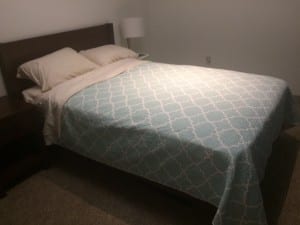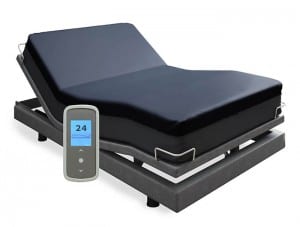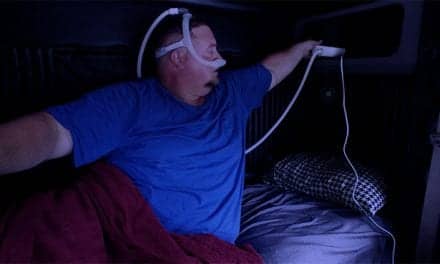A robust consumer mattress market means patient expectations are high, but practical considerations such as weight range, firmness, and ease of disinfection remain top of mind for sleep center managers.
A bed is no longer just a bed. There are eco-friendly mattresses that come with the promise of being made from organic, nontoxic materials. One new bed on the market gently rocks throughout the night, so even an adult can sleep like a baby. Then, of course, there are the pillow tops, and the memory foams that manufacturers say are useful for getting restful slumber, but how does all this technology in today’s consumer mattress industry affect mattress selection in sleep labs?
It turns out that picking mattresses for both clinical and research settings is less scientific than the sleep studies that these furnishings help capture. Most labs tend to bypass the high-tech in favor of practical considerations, including infection control, overall cost, and how adaptable the mattresses are for people with comorbid conditions and high BMIs. But many sleep lab managers would agree that as an infinite number of mattress options have flooded the consumer market over the last few years, labs have been forced to keep up with their patients’ growing expectations.
“They expect to be fed and treated as if it’s a hotel, not a medical test—on their schedule,” says Paula Applegate, RPSGT, manager of the sleep disorders center and neurodiagnostics lab at TriStar Centennial’s Sleep Disorders Center in Nashville, Tenn.
“I’ve had complaints that I didn’t have a pillow menu.”
Joseph Ojile, MD, DABSM, founder and chief medical officer at Clayton Sleep Institute in Missouri, says he has embraced the patients’ wishes for a “hotel experience” in the sleep labs his company manages throughout the Midwest.
For example, when possible, the medical supplies and wires are kept tucked away in a closet. Flat screen TVs perch over the head of the beds. Big recliners are nearby, where the patients can read by dim lighting before their test. There are individual heating and cooling systems in each room, so the patient can adjust the temperature to their liking. “The patients come in and they feel like they are going to a nice, warm, welcoming hotel,” says Ojile.
At the sleep research lab on the University of Massachusetts, Amherst (UMass), campus, participants have access to a small kitchen just steps away from the bedrooms. This way they can bring food to fix for breakfast before they head off to work or school in the morning. Granola bars are usually on hand, distributed by the sleep techs after the test is complete, says Rebecca Spencer, PhD, neuroscientist at the lab and UMass professor.
It’s also not uncommon for labs to collect surveys to measure their patients’ satisfaction levels with their test experience. Labs managed by Clayton Sleep Institute collect surveys and adjust the spaces as feedback comes in.

Air bladders, such as the one shown in this cutaway of a Sizewise Instant Comfort Sleep Lab Bed, are a popular choice for sleep labs. This mattress also features a gel layer to dissipate heat and a top layer of memory foam.
According to Ojile, one of the biggest considerations for selecting mattresses is the size of the patients, who tend to be larger than the average hotel guest. Clayton Sleep Institute typically uses queen mattresses that have air bladders, which can be adjusted for increased firmness to comfortably hold high-weight patients.
“First of all, we want to have the ability for a multitude of different body habitus to be comfortable, because a big part of the test performance is making sure that the patients are kept comfortable during the process,” says Ojile.
Mattresses that use air bladders are often a top choice for labs since they don’t lose support over time in the same way that a foam or spring mattress may, says Craig Miller, chief innovation officer of Sizewise, a mattress manufacturer that recently released a line of beds specifically for sleep labs.
The firmness can be adjusted with a remote control and the bed can hold patients of up to 1,000 pounds. The Sizewise bed may also be longer lasting and more cost effective than other options, says Miller, because as individual components wear out over time, these pieces can be updated without having to replace the entire mattress.
“The bed is renewable, so if one component is damaged or is worn out, you can just replace that component as well,” he says.

Mattresses with coil counts as high as 2,000 are a mattress manufacturer-recommended option for sleep labs that see many high BMI patients.
Mattresses with high coil counts, which can hold people who weight as much as 600 pounds, may also be a good choice for sleep labs, says Bruce Lujan, a commercial sales specialist with Mattress Firm.
For high-BMI clients, Lujan recommends that sleep lab managers look at queen-sized mattresses with coil counts as high as 1,000 to 2,000, which often come with a 10-year warranty, he says.
Infection control is another high priority for sleep lab managers and many report that they look for durable and impenetrable mattress covers.

At the sleep laboratory at the University of Massachusetts, Amherst, queen beds have zip-up covers underneath the sheets that are wiped down between patients to kill pathogens and protect the integrity of the mattress. Photography by Lisa Spear.
At the sleep laboratory at UMass, queen beds sit in a few sparsely furnished rooms, seemingly ready to welcome someone home at the end of the day with crisp white cotton sheets. But these rooms, disguised as typical bedrooms, will accommodate thousands of people over their lifetimes. The zip-up covers underneath the sheets can be easily wiped down between patients to kill pathogens and protect the integrity of the mattress.
At Spartanburg Regional Sleep Services in South Carolina, similar mattress covers are used, says Shari Angel Newman, RST, RPSGT, clinical manager of Regional Sleep Services.
Once soiled, the linens are removed and the beds and pillows are sprayed down with disinfectant and allowed to dry for 20 minutes. Spartanburg Regional Sleep Services sends the cotton-based mattress pads, sheets, and comforters for professional cleaning in accordance with Occupational Safety and Health Administration guidelines at water temperatures greater than 160 degrees Fahrenheit.
“Cleanliness is our number-one priority,” says Newman.
Any moisture is then wiped off before the bed is remade. Beds are inspected daily to assure there are no tears in the covers, says Newman.
Medical institutions can often lean on the commercial sales departments of mattress companies to guide them through the process of buying appropriate mattresses and covers. The manufacturer Sizewise has developed a polyurethane-coated mattress cover specifically for use in medical settings.
The polycarbonate additive coating was formulated to be highly resistant against the caustic chemical cleaners often used to disinfect between patients, says Miller.
According to Miller, the cover has been engineered to stretch so it doesn’t take away from the comfort of the mattress.

The Instant Comfort Sleep Lab Beds from Sizewise are air-adjustable beds with 45 levels of soft/firm comfort settings. The beds include an adjustable base.
To accommodate people who have comorbid conditions, adjustable position beds are often preferred in sleep clinics. Patients with respiratory diseases, gastroesophageal reflux disease, and back pain all could benefit from adjustable beds, says Applegate, a sleep lab manager.
At the Spartanburg Regional Healthcare System sleep clinic, patients can use wedge pillows to prop themselves up, but if significant elevation needed, the clinicians test in another location with hospital beds. These hospital beds are equipped with railings that can also accommodate people who experience seizures, says Newman.
To increase their comfort, people are encouraged to bring their own pillows, she adds.
The sleep clinic at Riddle Hospital in Pennsylvania recently outfitted its sleep center with adjustable bases from Mattress Firm that can help patients elevate their heads, if needed, according to Bill Howell, MBA, RRT-NPS, director of respiratory care and sleep medicine.
Firm mattresses are often ordered since most patients seem to prefer them. There are also clinical reasons to consider firmness. Extremely soft or worn out mattresses can cause the patient to sink or their neck to bend, affecting breathing. Not to mention, dusty mattresses and box springs can cause congestion and swelling of the airway (adding to the breathing difficulties), says Newman.
With all of these considerations in mind, sometimes it may be beneficial to just consult the manufacturer, especially if they have experience and knowledge of the sleep industry’s needs. Most large mattress companies will have a commercial sales department, where you can inquire about wholesale pricing. That’s what Howell did in his most recent round of mattress upgrades, consulting with Mattress Firm, to come up with a plan.
In the past, he tested mattresses himself, stopping at a mattress store on his drive home from work. Overall, he says, the selection process over the last few years has become more patient-oriented. “We are really interested in having the patient be comfortable as we are studying them,” says Howell.
There are a vast number of opinions on how to furnish sleep labs, but all can agree that sleeping away from home, with electrodes attached to the skin and a camera situated above the bed, can be challenging for some. So anything that lab managers can do to make the experience more comfortable, they may consider. But ultimately, Spencer says, “It’s just a matter of opinion; there is not a right or a wrong answer.”
Lisa Spear is associate editor of Sleep Review.





What you need is a buoyancy foam double sided mattress. They will last longer than a regular mattress, provided more pressure relief than memory foam, and be cooler while you sleep. One of the best decisions I ever made was buying an IDLE Sleep Mattress.
I was so happy to hear that sleep labs are starting to listen to their patients! I have been telling labs around Austin for years they need adjustable beds at the very least. All they ever are willing to do is provide an uncomfortable hospital bed the size of a gurney. My husband is 350 so you can imagine how he felt. I usually stay with him in the room because he needs my help and there are no comfortable recliners just the hospital room kind.
No one had adjustable beds in Austin. I have been asking for those for people for yeasts. You usually cannot even make the room really cold either due to management restrictions. I have read 65-66 degrees is best to sleep. They don’t accommodate large patients like the places in the article does. My husband has claustrophobia so these tests are very difficult for him to do. Sometimes he’s been unable to do the test because of all the problems we have had with the sleep environment at the labs and they just blame it on the patient. Bathrooms should always be in the same room not shared or down the hall. I didn’t know there were actually labs out there listening to their patients. I commend them because it DOES matter. I hope Austin catches up soon.
Hey Renee, I actually sell to a lot of different institutions and always recommend adjustable bases but because of budgets most sleep centers don’t go for them.
If you ever need help please reach out [email protected]. I can extend our wholesale pricing to you and your husband as well if you were thinking about buying an adjustable base. Hope this helps.
Being able to sleep comfortably outside of one’s own bed while attached to a myriad of wires could seem an impossible feat. But it’s really not. Rarely does a sleep study fail because the patient was unable to sleep. You think that you simply didn’t get any sleep during your overnight sleep study, you’ll be surprised to seek out that you simply slept far more than you realized. The likelihood is that you slept enough to get an adequate amount of knowledge.
Si por el contrario, tienes la costumbre de dormir de lado o en posición fetal, necesitarás menor dureza. En lugar de elegir colchones firmes, para que los hombros queden adaptados en una posición cómoda que induzca al sueño.